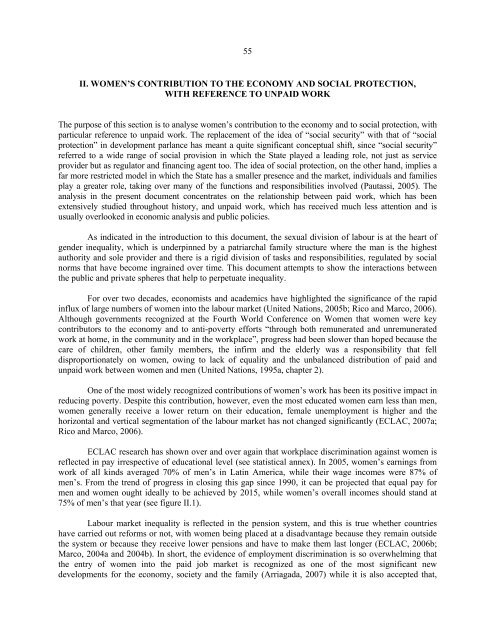Women in Latin America and the Caribbean - Cepal
Women in Latin America and the Caribbean - Cepal
Women in Latin America and the Caribbean - Cepal
Create successful ePaper yourself
Turn your PDF publications into a flip-book with our unique Google optimized e-Paper software.
55<br />
II. WOMEN’S CONTRIBUTION TO THE ECONOMY AND SOCIAL PROTECTION,<br />
WITH REFERENCE TO UNPAID WORK<br />
The purpose of this section is to analyse women’s contribution to <strong>the</strong> economy <strong>and</strong> to social protection, with<br />
particular reference to unpaid work. The replacement of <strong>the</strong> idea of “social security” with that of “social<br />
protection” <strong>in</strong> development parlance has meant a quite significant conceptual shift, s<strong>in</strong>ce “social security”<br />
referred to a wide range of social provision <strong>in</strong> which <strong>the</strong> State played a lead<strong>in</strong>g role, not just as service<br />
provider but as regulator <strong>and</strong> f<strong>in</strong>anc<strong>in</strong>g agent too. The idea of social protection, on <strong>the</strong> o<strong>the</strong>r h<strong>and</strong>, implies a<br />
far more restricted model <strong>in</strong> which <strong>the</strong> State has a smaller presence <strong>and</strong> <strong>the</strong> market, <strong>in</strong>dividuals <strong>and</strong> families<br />
play a greater role, tak<strong>in</strong>g over many of <strong>the</strong> functions <strong>and</strong> responsibilities <strong>in</strong>volved (Pautassi, 2005). The<br />
analysis <strong>in</strong> <strong>the</strong> present document concentrates on <strong>the</strong> relationship between paid work, which has been<br />
extensively studied throughout history, <strong>and</strong> unpaid work, which has received much less attention <strong>and</strong> is<br />
usually overlooked <strong>in</strong> economic analysis <strong>and</strong> public policies.<br />
As <strong>in</strong>dicated <strong>in</strong> <strong>the</strong> <strong>in</strong>troduction to this document, <strong>the</strong> sexual division of labour is at <strong>the</strong> heart of<br />
gender <strong>in</strong>equality, which is underp<strong>in</strong>ned by a patriarchal family structure where <strong>the</strong> man is <strong>the</strong> highest<br />
authority <strong>and</strong> sole provider <strong>and</strong> <strong>the</strong>re is a rigid division of tasks <strong>and</strong> responsibilities, regulated by social<br />
norms that have become <strong>in</strong>gra<strong>in</strong>ed over time. This document attempts to show <strong>the</strong> <strong>in</strong>teractions between<br />
<strong>the</strong> public <strong>and</strong> private spheres that help to perpetuate <strong>in</strong>equality.<br />
For over two decades, economists <strong>and</strong> academics have highlighted <strong>the</strong> significance of <strong>the</strong> rapid<br />
<strong>in</strong>flux of large numbers of women <strong>in</strong>to <strong>the</strong> labour market (United Nations, 2005b; Rico <strong>and</strong> Marco, 2006).<br />
Although governments recognized at <strong>the</strong> Fourth World Conference on <strong>Women</strong> that women were key<br />
contributors to <strong>the</strong> economy <strong>and</strong> to anti-poverty efforts “through both remunerated <strong>and</strong> unremunerated<br />
work at home, <strong>in</strong> <strong>the</strong> community <strong>and</strong> <strong>in</strong> <strong>the</strong> workplace”, progress had been slower than hoped because <strong>the</strong><br />
care of children, o<strong>the</strong>r family members, <strong>the</strong> <strong>in</strong>firm <strong>and</strong> <strong>the</strong> elderly was a responsibility that fell<br />
disproportionately on women, ow<strong>in</strong>g to lack of equality <strong>and</strong> <strong>the</strong> unbalanced distribution of paid <strong>and</strong><br />
unpaid work between women <strong>and</strong> men (United Nations, 1995a, chapter 2).<br />
One of <strong>the</strong> most widely recognized contributions of women’s work has been its positive impact <strong>in</strong><br />
reduc<strong>in</strong>g poverty. Despite this contribution, however, even <strong>the</strong> most educated women earn less than men,<br />
women generally receive a lower return on <strong>the</strong>ir education, female unemployment is higher <strong>and</strong> <strong>the</strong><br />
horizontal <strong>and</strong> vertical segmentation of <strong>the</strong> labour market has not changed significantly (ECLAC, 2007a;<br />
Rico <strong>and</strong> Marco, 2006).<br />
ECLAC research has shown over <strong>and</strong> over aga<strong>in</strong> that workplace discrim<strong>in</strong>ation aga<strong>in</strong>st women is<br />
reflected <strong>in</strong> pay irrespective of educational level (see statistical annex). In 2005, women’s earn<strong>in</strong>gs from<br />
work of all k<strong>in</strong>ds averaged 70% of men’s <strong>in</strong> Lat<strong>in</strong> <strong>America</strong>, while <strong>the</strong>ir wage <strong>in</strong>comes were 87% of<br />
men’s. From <strong>the</strong> trend of progress <strong>in</strong> clos<strong>in</strong>g this gap s<strong>in</strong>ce 1990, it can be projected that equal pay for<br />
men <strong>and</strong> women ought ideally to be achieved by 2015, while women’s overall <strong>in</strong>comes should st<strong>and</strong> at<br />
75% of men’s that year (see figure II.1).<br />
Labour market <strong>in</strong>equality is reflected <strong>in</strong> <strong>the</strong> pension system, <strong>and</strong> this is true whe<strong>the</strong>r countries<br />
have carried out reforms or not, with women be<strong>in</strong>g placed at a disadvantage because <strong>the</strong>y rema<strong>in</strong> outside<br />
<strong>the</strong> system or because <strong>the</strong>y receive lower pensions <strong>and</strong> have to make <strong>the</strong>m last longer (ECLAC, 2006b;<br />
Marco, 2004a <strong>and</strong> 2004b). In short, <strong>the</strong> evidence of employment discrim<strong>in</strong>ation is so overwhelm<strong>in</strong>g that<br />
<strong>the</strong> entry of women <strong>in</strong>to <strong>the</strong> paid job market is recognized as one of <strong>the</strong> most significant new<br />
developments for <strong>the</strong> economy, society <strong>and</strong> <strong>the</strong> family (Arriagada, 2007) while it is also accepted that,











